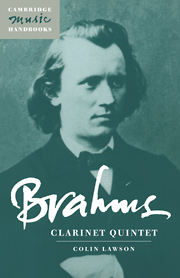Book contents
- Frontmatter
- Contents
- List of illustrations
- Preface
- 1 The nineteenth-century clarinet and its music
- 2 Brahms and the orchestral clarinet
- 3 Brahms's chamber music before 1891
- 4 The genesis and reception of the Clarinet Quintet
- 5 Design and structure
- 6 Performance practice
- 7 The legacy of Brahms's clarinet music
- Appendix 1 A list of Brahms's chamber music
- Appendix 2 A review of the first London performance,The Times,29 March 1892
- Appendix 3 The mechanism of Mühlfeld's Baermann-Ottensteiner clarinets
- Notes
- Select bibliography
- Index
5 - Design and structure
Published online by Cambridge University Press: 05 June 2012
- Frontmatter
- Contents
- List of illustrations
- Preface
- 1 The nineteenth-century clarinet and its music
- 2 Brahms and the orchestral clarinet
- 3 Brahms's chamber music before 1891
- 4 The genesis and reception of the Clarinet Quintet
- 5 Design and structure
- 6 Performance practice
- 7 The legacy of Brahms's clarinet music
- Appendix 1 A list of Brahms's chamber music
- Appendix 2 A review of the first London performance,The Times,29 March 1892
- Appendix 3 The mechanism of Mühlfeld's Baermann-Ottensteiner clarinets
- Notes
- Select bibliography
- Index
Summary
Introduction
Although Brahms's Clarinet Quintet is traditionally regarded as an autumnal and even nostalgic work, its formal architecture is in no sense reactionary. Furthermore, Brahms's integration of clarinet and strings is a substantial achievement in its own right, with fewer opportunities for bravura than for refined musicality, intimate expression and beautiful tone. While the Quintet's nostalgic elements have tended to be emphasised in performance, there are darker and more vigorous aspects to the material, including the fantastic gypsy music in the Adagio. In this part of the work the clarinet moves momentarily to centre stage from its role as primus inter pares. The clarinet's large effective range, tonal flexibility and dynamic variety enable it variously to merge with the strings and to stand out clearly as soloist. The richness of the A clarinet emphasises the sombre colours of the instrument's lowest register, as well as providing an extra low semitone not available on the more brilliant B♭.
The character and mood of Brahms's Clarinet Quintet is markedly influenced by the degree to which the tonic key of B minor prevails. Even though the Adagio is in B major, it contains a tinge of minor and has a middle section emphatically within that mode. The third movement begins in D major, but the single definite modulation in the first section is to B minor. Its Presto is a complete sonata movement in B minor, turning to D only at the end.
Information
- Type
- Chapter
- Information
- Brahms: Clarinet Quintet , pp. 47 - 65Publisher: Cambridge University PressPrint publication year: 1998
